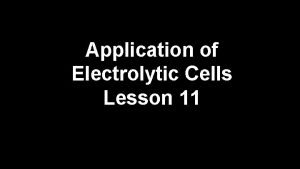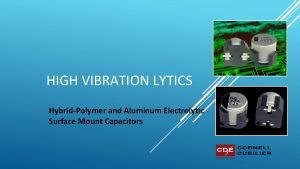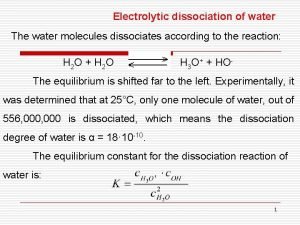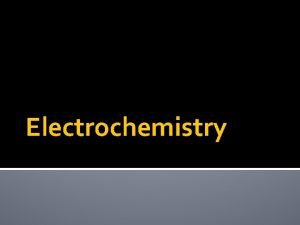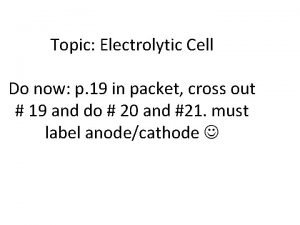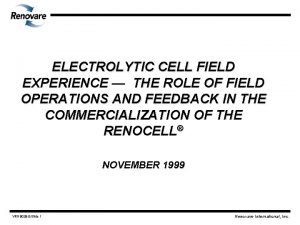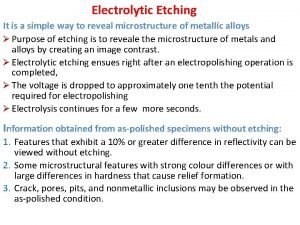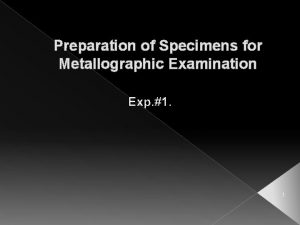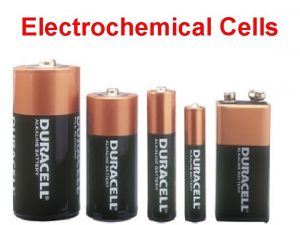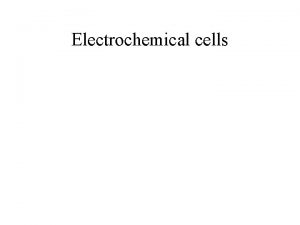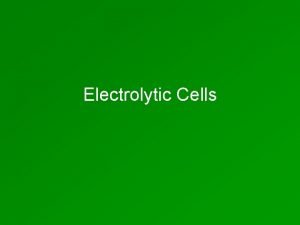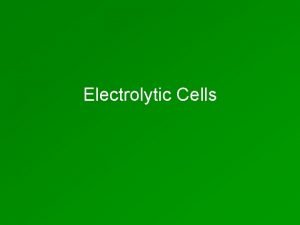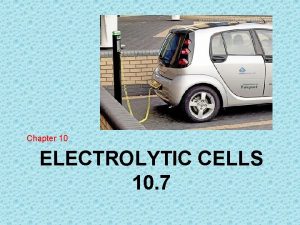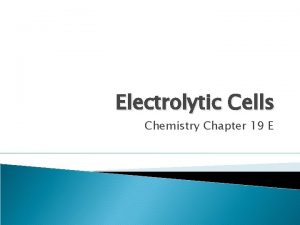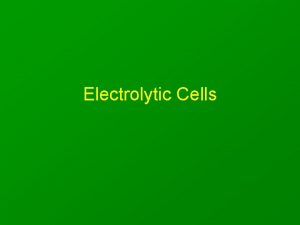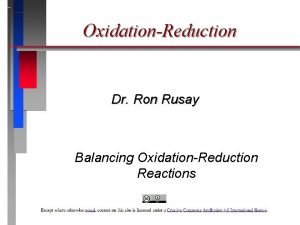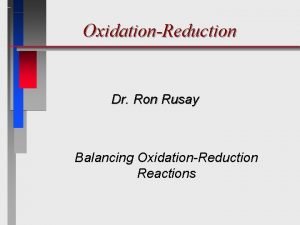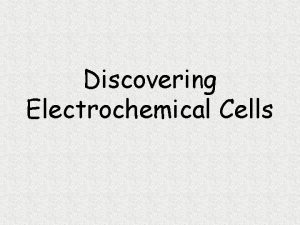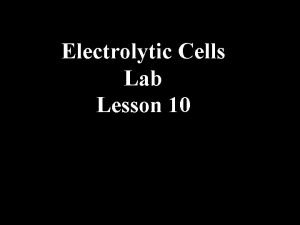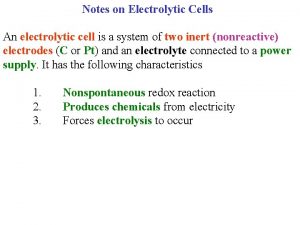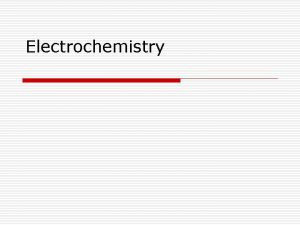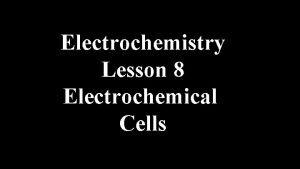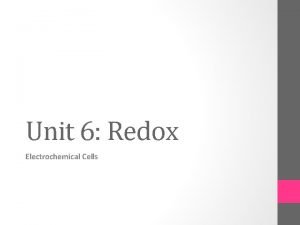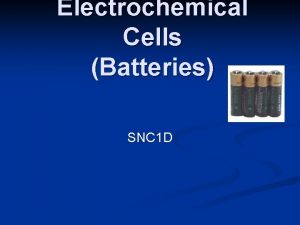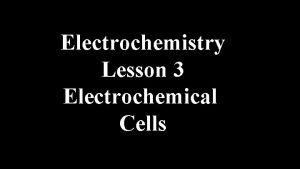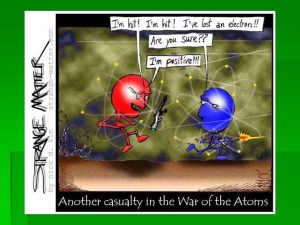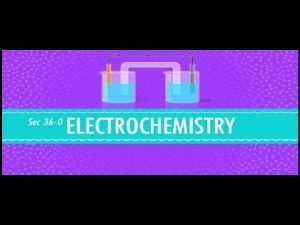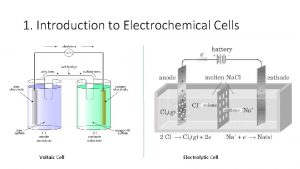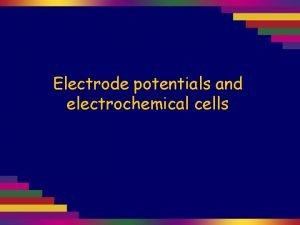Topic 9 OxidationReduction 9 2 Electrochemical Cells Electrolytic


























- Slides: 26

Topic 9 – Oxidation-Reduction 9. 2 – Electrochemical Cells Electrolytic Cells 1

Electrolytic vs. Voltaic Cells How do voltaic and electrolytic cells differ? 2

Electrolytic vs. Voltaic Cells The process in which electrical energy is used to bring about a chemical change is called electrolysis. • You are already familiar with some results of electrolysis, such as gold-plated jewelry, chrome-plated automobile parts, and silver-plated dishes. 3

Electrolytic vs. Voltaic Cells The apparatus in which electrolysis is carried out is an electrolytic cell. • An electrolytic cell uses electrical energy (direct current) to make a non-spontaneous redox reaction proceed to completion. • An electrolytic cell is an electrochemical cell used to cause a chemical change through the application of electrical energy. 4

Electrolysis Using electrical energy to produce chemical change. Sn 2+(aq) + 2 Cl-(aq) ---> Sn(s) + Cl 2(g) Sn. Cl 2(aq) Cl 2 Sn 5

In electrolysis, an electric current is used to do which of the following? A. Cause a chemical change B. Produce a battery C. Generate heat D. Run a motor Copyright © Pearson Education, Inc. , or its affiliates. All Rights Reserved. 6

In electrolysis, an electric current is used to do which of the following? A. Cause a chemical change B. Produce a battery C. Generate heat D. Run a motor 7

Electrolytic Cells Driving Nonspontaneous Processes What are some applications that use electrolytic cells? 8

Electrolysis of Water Anode (+) 2 H 2 O ---> O 2(g) + 4 H+ + 4 e- Cathode (-) 4 H 2 O + 4 e- ---> 2 H 2 + 4 OH- 9

Electrolysis of Water The overall cell reaction is obtained by adding the half-reactions (after doubling the reduction half-reaction equation to balance electrons). Oxidation: 2 H 2 O(l) → O 2(g) + 4 H+(aq) + 4 e– Reduction: 2 [2 H 2 O(l) + 2 e– → H 2(g) + 2 OH–(aq)] 6 H 2 O(l) → 2 H 2(g) + O 2(g) + 4 H+(aq) + 4 OH–(aq) 10

Quantitative Aspects of Electrochemistry electrolysis of aqueous silver ion. Ag+ (aq) + e- ---> Ag(s) 1 mol e- ---> 1 mol Ag If the moles of e- are measured, can determine the quantity of Ag formed. But how to measure moles of e-? 11

Quantitative Aspects of Electrochemistry • Measure the electrical current Units 12

Quantitative Aspects of Electrochemistry But how is charge related to moles of electrons? = 96, 500 C/mol e- = 1 Faraday 13

Michael Faraday 1791 -1867 Originated the terms anode, cathode, anion, cation, electrode. Discoverer of • electrolysis • magnetic props. of matter • electromagnetic induction • benzene and other organic chemicals 14

Faraday’s Law Example: Calculate the mass of bromine liquid produced in the electrolysis of an aqueous solution of sodium bromide if a current of 2. 50 A is passed through the solution for 3. 0 hr. General Strategy Solution Determine the correctly balanced equation for the electrolysis reaction. 2 Br− −−> Br 2 + 2 e− 2 H 2 O(l) + 2 e− −−> H 2 (g) + 2 OH− (aq) 2 Br− + 2 H 2 O(l) −−> Br 2 + H 2 (g) + 2 OH− (aq) Determine the number of coulombs. C = A x s Using Faraday’s Law, moles of electrons exchanged, and molar mass, determine the grams of the desired material produced. Remember that 1 mole of electrons = 96, 500 C (1 Faraday). 1 C = 1 A x 1 s 60 min 60 s = 2. 50 A x 3. 0 hrs. x --------1 hr 1 min = 27, 000 C 1 mol Br 2 160. g 1 mol e− 27, 000 C x ----------------- x -------2 mol e− 1 mol Br 2 96, 500 C = 22. 3 g Br 2 = 22 g Br 2 15

16

Faraday’s Law 1. 50 A flow thru a Ag+(aq) solution for 15. 0 min. What mass of Ag metal is deposited? Solution: Calc. charge Charge (C) = current (A) x time (t) = (1. 5 A)(15. 0 min)(60 s/min) = 1350 C 17

Faraday’s Law Charge = 1350 C NEXT: Calculate moles of e- used (c) Calc. quantity of Ag 18

Pb(s) + HSO 4 -(aq) −−> Pb. SO 4(s) + H+(aq) + 2 e. If a battery delivers 1. 50 A, and you have 454 g of Pb, how long will the battery last? Solution a) 454 g Pb = 2. 19 mol Pb b) Calculate moles of e− c) Calculate charge (4. 38 mol e−)(96, 500 C/mol e−) = 423, 000 C 19

Faraday’s Law NEXT: Use Charge = 423, 000 C d) Calculate time About 78 hours 20

Faraday’s Law Example: A 1. 0 M aqueous solution of chromium(III) bromide will be electrolyzed to “chrome plate” a faucet. How many hours will it take to deposit 75. 0 g of chromium metal from the solution when a current of 3. 00 A is running through the solution? General Strategy Solution Determine the number of moles of electrons needed to plate out 1 mol of metal. Write the half reaction. Cr 3+(aq) + 3 e− −−> Cr(s) Using dimentional analysis, determine the number of coulombs required. 3 mol e− 96, 500 C 1 mol Cr = 75. 0 g Cr x ---------------- x --------1 mol Cr 1 mol e− 52. 0 g Cr = 418, 000 C Determine the time required C = A x s 3 mol of electrons C = A x s 418, 000 C = 3. 00 A x s s = 139, 333 s = 38. 7 hrs. 21

22

YOUR TURN A current equivalent to 0. 500 Faradays is passed through a solution containing copper(II) sulfate, Cu. SO 4. How much copper can be plated out? A. B. C. D. E. 64. 0 32. 0 15. 9 7. 00 3. 20 g g g 23

Solution A current equivalent to 0. 500 Faradays is passed through a solution containing copper(II) sulfate, Cu. SO 4. How much copper can be plated out? Cu 2+ Cu + 2 e− 0. 500 Faradays = 0. 500 mol e− x ½ mol Cu = 0. 250 mol Cu x 63. 55 g/mol = 15. 89 g 24

Solution A current equivalent to 0. 500 Faradays is passed through a solution containing copper(II) sulfate, Cu. SO 4. How much copper can be plated out? A. B. C. D. E. 64. 0 32. 0 15. 9 7. 00 3. 20 g g g 25

Homework Review Sections 9. 1 and 9. 2. Review questions at the end of Topic 9. Complete Kerboodle quiz 9. 2. Study for TEST. 26
 Application of electrolytic cell
Application of electrolytic cell Electrolysis vs voltaic cell
Electrolysis vs voltaic cell Khan academy electrolysis
Khan academy electrolysis Cuál es la diferencia entre la célula animal y vegetal
Cuál es la diferencia entre la célula animal y vegetal Pseudostratified vs simple columnar
Pseudostratified vs simple columnar Why dna is more stable than rna?
Why dna is more stable than rna? Prokaryotes vs eukaryotes venn diagram
Prokaryotes vs eukaryotes venn diagram Dr saja
Dr saja Are red blood cells prokaryotic
Are red blood cells prokaryotic Chlorocruorin
Chlorocruorin Why did robert hooke name cells “cells”?
Why did robert hooke name cells “cells”? Parafollicular cells vs follicular cells
Parafollicular cells vs follicular cells Nondisjunction in meiosis
Nondisjunction in meiosis Prokaryotic vs eukaryotic cells
Prokaryotic vs eukaryotic cells Masses of cells form and steal nutrients from healthy cells
Masses of cells form and steal nutrients from healthy cells How are somatic cells different from gametes
How are somatic cells different from gametes Cells cells they're made of organelles meme
Cells cells they're made of organelles meme Plant and animal cells venn diagram
Plant and animal cells venn diagram Pns water view position
Pns water view position Smt for electrolytic cell
Smt for electrolytic cell Dissociated meaning
Dissociated meaning Electrolytic decomposition example
Electrolytic decomposition example Anode is positive in electrolytic cell
Anode is positive in electrolytic cell Anode and cathode in galvanic cell
Anode and cathode in galvanic cell Applications of electrolytic cell
Applications of electrolytic cell Electrolytic etching
Electrolytic etching Electrolytic etching metallography
Electrolytic etching metallography
